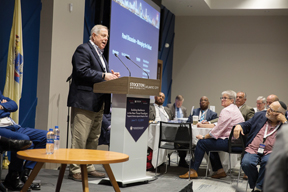
Stay alert and practice responses.
That’s the main advice from Todd Stettner to Kansas City-area residents to prepare for the possibility of and respond to the occurrence of violence against people of faith.
Stettner took part in a panel discussion titled “Managing the Fallout” at a summit called “Building Resilience in the New Threat Paradigm: Targeting Violence Against People of Faith,” held in Atlantic City, New Jersey, June 11 and 12. The summit was sponsored by Rutgers University and Stockton University in partnership with the New Jersey Office of Homeland Security and Preparedness. It drew nearly 200 representatives from law enforcement agencies and faith-based groups across the United States and in Europe.
Stettner was president and CEO of the Jewish Federation of Greater Kansas City from 1999 to 2017. He owns Stettner Consulting in Olathe and is a member of Kehilath Israel Synagogue.
The panel discussion he took part in also included panelists from England, Belgium and Montana. They discussed how to handle threats and attacks.
Some of the information presented at the summit was a review for Stettner, he said, because he had gone through the April 2014 shootings outside local Jewish facilities. Reat Underwood, Dr. William Corporon and Teresa LaManno were murdered by a self-described neo-Nazi who had mistakenly thought they were Jewish and shot them. The perpetrator was convicted of the crimes and in late 2015 was sentenced to death.
“I had a lot to do and learned a lot about security during that time period,” Stettner said.
Every faith-based organization faces this kind of threat, he said, including Jewish, Islamic, Christian and other groups. One problem they all face is how to “keep an open, welcoming environment and at the same time prepare for these kinds of incidents.”
“Israel (for example) is very conscious (of threats),” he said. “(If people) see a package or briefcase on the sidewalk, they’re quick to report it.”
The need for this habit came into sharp focus in the two years after the 2014 shootings in the Kansas City area, Stettner said.
“Make people conscious of the need for security, aware of their surroundings and what to do in these situations, at faith-based institutions and schools and public buildings,” he said. “Run, hide, fight — who knew (this principle when an attack occurs) five years ago? We knew run and hide. In our training with DHS (the U.S. Department of Homeland Security) after the 2014 incidents, that’s what we discussed. And what do you do in the aftermath of a tragedy. We did a mock tabletop exercise in a church about what to do in the aftermath — how do you cope with all these things?”
An active-shooter plan was in place at the Jewish Community Campus for two years before the 2014 shootings, Stettner said, “but we probably should’ve practiced it more.”
“It was based on (the possibility of) an incident inside the facility, not in the parking lot,” he said. “You have to have leaders who are good at improvising and thinking on their feet,” and that also extends to everyone else.
Stettner raised money in the community to hire a security director and secure a patrol car for the Jewish Community Campus after the 2014 shooting, he said. Village Shalom and Congregation Beth Israel Abraham & Voliner (BIAV) received grants through DHS to improve the security of their buildings.
“The congregations were terrific,” Stettner said. “They embraced the culture of security, hardening facilities and using our security director to help train their people.”
According to written information provided by Rutgers, the summit’s “overarching goal is to connect theoretical research with real-world experience to devise practical and achievable approaches to the problem of extremist violence.” Organizers and participants sought to:
• Establish an Interfaith Resilience Coalition of faith-based institutions and other stakeholders to share information and best practices within and among communities.
• Form a unified approach and common standard to create safer faith-based communities.
• Strengthen relationships with law enforcement officials.
• Clarify faith communities’ needs in order to develop relationships with federal and state law enforcement agencies.
• Publish an ongoing online guide to identify and implement best practices.
Stettner said that, in his view, the summit’s most important session was presented by Rabbi Francine Roston of Whitefish, Montana. She gave a talk about her experience of having been targeted by a white supremacist group. He also met with Jonathan Biermann, deputy mayor of Uccle in Brussels, who had developed a crisis plan before a museum was attacked in his city.
Stettner said he had found several other sessions especially interesting, including one about cyber security. Tony Sgro, founder and CEO of EdVenture Partners, gave a presentation about a program called Peer to Peer: Challenging Extremism to educate college students to “be more careful and analyze more what they see on the internet, and to build an international program which is countering hate, extremism and incidents of violence.”
Resilience to these threats has increased somewhat because of the various shootings that have occurred, Stettner said.
“More and more organizations are waking up to this fact (of growing threats),” he said. “They are increasing in the U.S. and elsewhere in the world. Some people are taking lightly the threat of the right-wing and left-wing extremism in Europe. The number of right-wing and, to a lesser extent, left-wing extremist views in governments in Europe is increasing dramatically. They are a growing minority in these governments.”
Visit stockton.edu/buildingresilience to watch a video of the summit.


